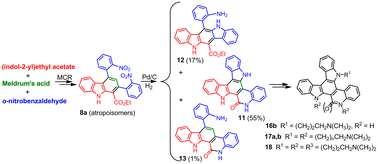A short route, involving a tetramolecular condensation reaction and a Pd/C catalyst–H2-mediated reductive N-heteroannulation as the key-steps, has been found for the synthesis of some new penta- and heptacyclic indolo- (12), quinolino- (13) and indoloquinolinocarbazole (11) derivatives. HF-DFT (B3LYP) energy profiles and NMR calculations were carried out to help in the understanding of the experimental results. N-Alkylated indoloquinolinocarbazoles (16b, 17a, 17b and 18) were prepared and screened essentially toward some cancer-(G-quadruplex, DNA, topoisomerase I) and CNS-related (kinases) targets. Biological results evidenced 13 as a potent CDK-5 and GSK-3β kinases inhibitor, while di- or triaminopropyl-substituted indoloquinolinocarbazoles 17b or 18 targeted rather DNA-duplex or telomeric G-quadruplex structures, respectively.

